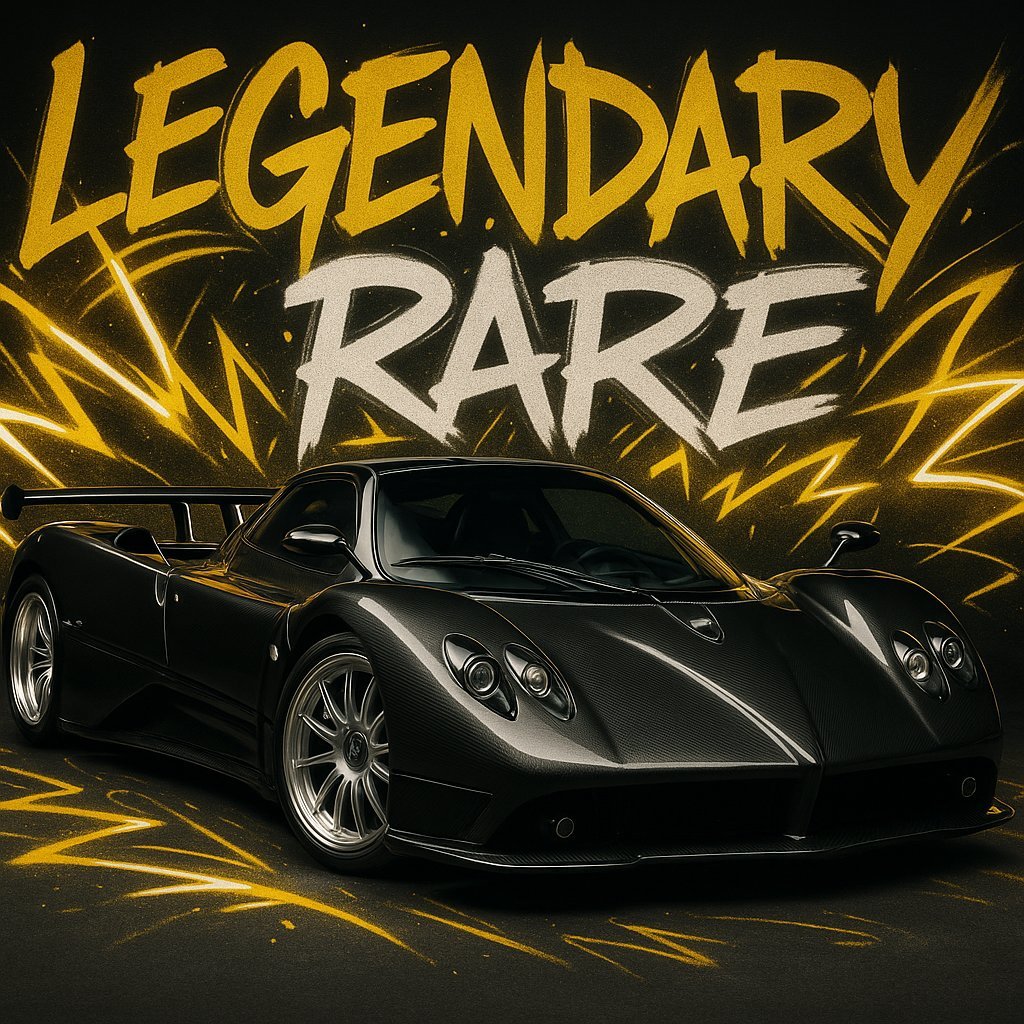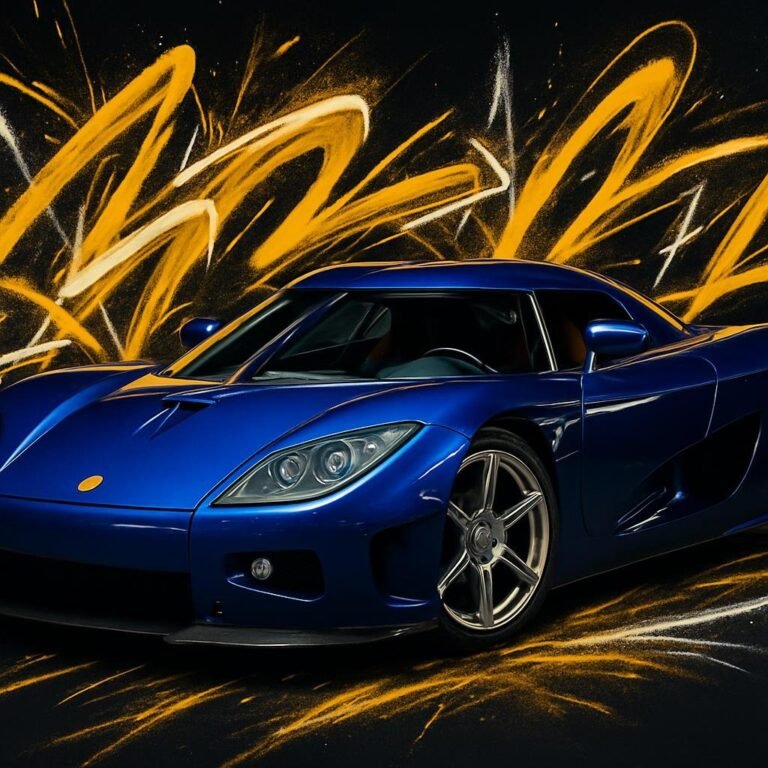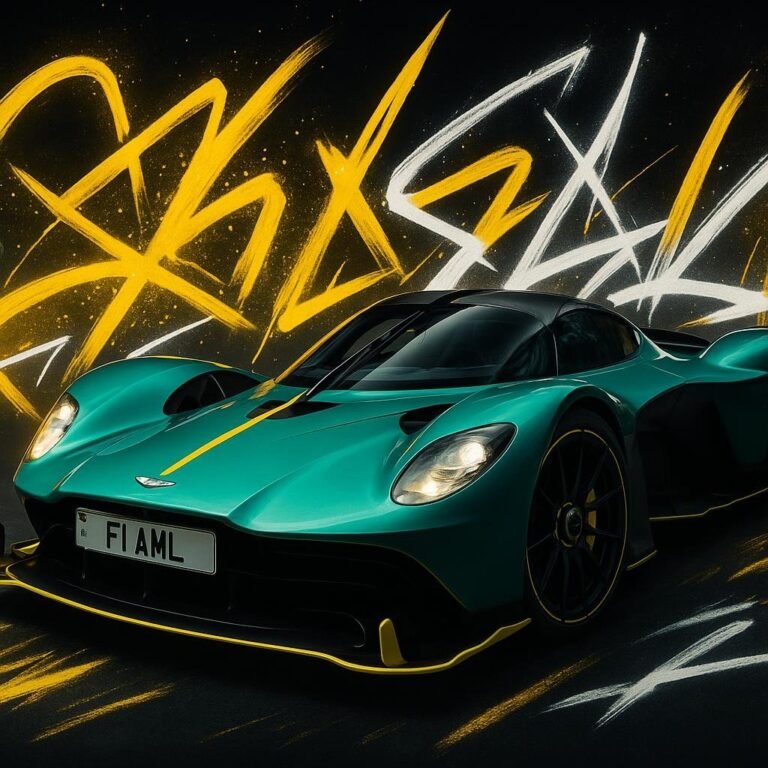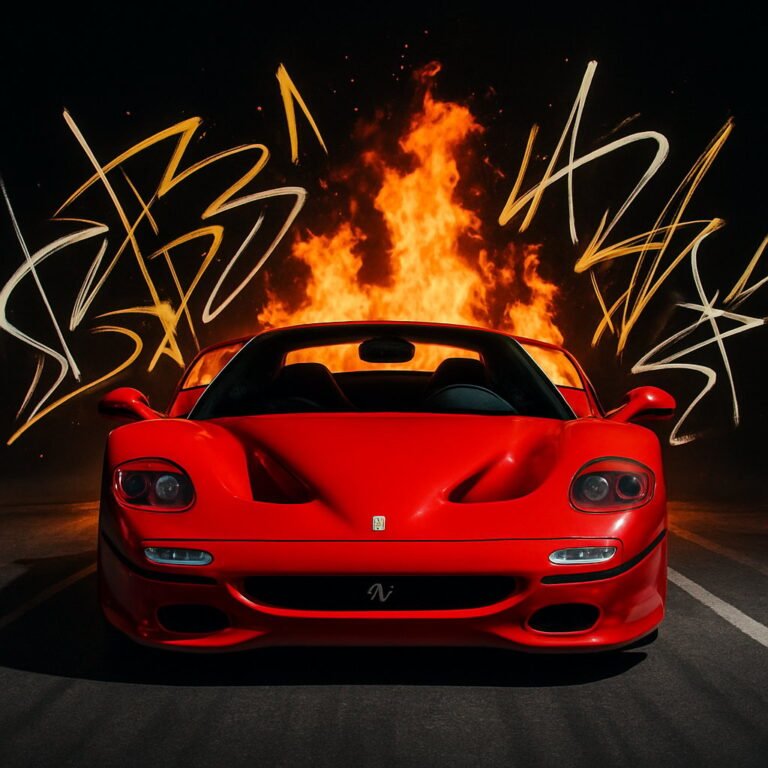Back in 1999, the Pagani Zonda C12 burst onto the scene, introducing the world to Horacio Pagani’s wild dream—Italian art fused with German engineering. This wasn’t just another supercar; it was the first production model from Pagani Automobili, powered by a Mercedes-Benz AMG V12 and wrapped in carbon fiber that made people rethink what a modern supercar could be.
Originally, Pagani planned to name it after Formula 1 legend Juan Manuel Fangio, but after Fangio passed in 1995, he respectfully renamed it Zonda. The name? It comes from a fierce wind that sweeps across Argentina—pretty poetic, right?
Pagani Zonda C12 history and origins are rooted in Horacio’s childhood obsession with cars and the iconic Silver Arrow Mercedes racing machines. When the C12 hit the 1999 Geneva Motor Show, jaws hit the floor. Only five original C12s ever rolled out, so if you see one, you’re looking at a unicorn.
Every one of those five cars showcases a blend of lightweight carbon fiber construction and a bellowing 6.0-liter V12, cranking out 394 horsepower. It’s not just a car; it’s a rolling piece of art and engineering history.
Pagani didn’t just want to build a car. He wanted to challenge the likes of Ferrari and Lamborghini with something nobody had seen before. That rare mix of art, cutting-edge materials, and Mercedes-AMG V12 performance set the template for every Zonda that followed.
Nowadays, these C12s are basically the holy grail for collectors. Their rarity and story have sent prices soaring, and if you’re lucky enough to have one in your garage, you’re sitting on a gold mine.
Backstory and Development
The Pagani Zonda C12’s story is pure passion—Horacio Pagani’s relentless quest for perfection, inspired by racing legend Juan Manuel Fangio. After years at Lamborghini, Pagani set out to blaze his own trail and shake up the supercar world.
Vision and Motivation Behind the Zonda C12 GTO
Pagani wanted more than a fast car. He wanted to build a masterpiece—a vehicle where art and engineering danced together. The late 1990s supercar scene needed a wake-up call, and Pagani was happy to deliver it.
He set out to combine featherweight carbon fiber with the thunderous Mercedes-Benz V12. Imagine strapping yourself into a fighter jet—on wheels. That’s what he was after.
Key Design Goals:
- Ultra-lightweight carbon fiber monocoque
- Distinctive aerodynamic styling
- Hand-built craftsmanship quality
- Track-focused performance with road usability
The Zonda C12 was designed by Horacio Pagani and inspired by Mercedes-Benz Group C racers. That’s why the car just looks fast standing still—every line has a purpose.
Pagani said no to mass production. Instead, he decided to build just a handful of cars, each one crafted with obsessive care. That’s a bold move, but it’s what makes the Zonda C12 so special.
Horacio Pagani’s Inspiration and Early Influences
Pagani cut his teeth at Lamborghini, working on legends like the Countach Evoluzione. That’s where he first fell in love with carbon fiber.
He dove deep into materials science, borrowing ideas from aerospace to make the Zonda lighter and stronger than anything else out there. He was obsessed—some say in the best way possible.
Le Mans prototypes from the ‘80s and ‘90s lit the fire for Pagani’s vision. He wanted the Zonda to have that same drama and performance—just with a lot more Italian flair.
Major Influences:
- Group C racing prototypes
- Art Nouveau architectural elements
- Aircraft design principles
- Italian craftsmanship traditions
Pagani’s friendship with Juan-Manuel Fangio fueled his determination. It wasn’t just about building a car—it was about chasing a dream, with a little help from a racing legend.
Role of Juan Manuel Fangio in Concept Evolution
Fangio wasn’t just a name on a plaque—he was Pagani’s mentor. The five-time Formula One champ gave real feedback on how the car should feel and handle.
His advice shaped everything from the Zonda’s balance to its driver-focused cockpit. If you ever wondered why it feels so alive, thank Fangio.
His Mercedes-Benz connections? Priceless. That’s how Pagani got his hands on those glorious V12s—a match made in heaven, honestly.
After Fangio passed in 1995, Pagani doubled down on making the Zonda a tribute worthy of his hero. The Zonda came about through Pagani’s friendship with the late Juan-Manuel Fangio.
Origins of Pagani Automobili and Modena Design
Pagani set up shop in Modena, Italy—right in the heart of supercar country. Surrounded by Ferrari, Lamborghini, and Maserati, he had access to the best craftsmen in the business.
Before the Zonda, Modena Design did carbon fiber consulting for other brands. That side hustle paid the bills and helped Pagani master the material.
His team was tiny but mighty. Every part was hand-crafted, every detail obsessed over. Quality wasn’t just a goal—it was a religion.
Company Timeline:
- 1992: Modena Design founded
- 1994: First Zonda prototypes begin
- 1998: Pagani Automobili officially established
- 1999: Zonda C12 debuts at Geneva Motor Show
Only five original C12s were ever completed. That’s why you almost never see one in the wild—they’re the rarest of the rare.
Debut and Public Reception
The Pagani Zonda C12 made its big entrance at the 1999 Geneva Motor Show. Horacio Pagani’s first production vehicleflipped the script on what a supercar could be. The carbon fiber body alone was enough to make even Ferrari fans do a double take.
1999 Geneva Motor Show Reveal
When the Zonda C12 hit Geneva, it wasn’t just another debut—it was a declaration. Pagani took everything he learned at Lamborghini and built something the world hadn’t seen before.
That carbon fiber construction? It wasn’t just for show. Pagani used his composite know-how to make the chassis light but tough as nails.
The windshield curves and jet-inspired interior? Pure theater. Pagani wanted every inch to feel special, and he nailed it.
Key Debut Specifications:
- Engine: Mercedes-AMG 6.0L V12
- Construction: Carbon fiber monocoque
- Design Philosophy: Blend of art and engineering
Immediate Reactions from Industry and Media
The first time people saw the Zonda, you could hear the collective gasp. It was bold, different, and unapologetically Pagani.
Journalists raved about the carbon fiber everywhere. In 1999, using so much composite was borderline insane—it was expensive and tricky to work with.
The cockpit was like nothing else: switches, dials, and details straight out of an aircraft. Luxury met race car, and reviewers couldn’t get enough.
Critics loved how the Zonda stood out from the usual Italian crowd. Pagani wasn’t copying anyone—he was setting his own course.
Collector Hype and Scarcity from Launch
From day one, Pagani kept production super limited. Only a few lucky folks could order a Zonda C12, and that exclusivity made collectors sit up and pay attention.
The first Zonda wasn’t just another supercar. It was the start of something new, and collectors knew it.
Production Numbers:
- C12 6.0: Five original cars
- Total Zondas (all variants): 140 cars by 2019
- Development mules: Included in total count
Every Zonda C12 was a bespoke creation. That personal touch is a big part of what makes them so valuable now—each one is a story on wheels.
Noteworthy Behind-the-Scenes Anecdotes
Pagani’s friendship with Fangio wasn’t just for show—it shaped the Zonda’s racing soul. The car’s focus on handling and driver connection owes a lot to Fangio’s advice.
When Pagani restored chassis number 001 for the Zonda’s 20th anniversary, it was a full-circle moment. That original show car returned to Geneva, looking better than ever.
Pagani himself oversaw each build. He was in the trenches with his team, making sure every detail was perfect. That hands-on spirit is rare these days.
The name “Zonda” isn’t just cool—it’s personal. It’s a nod to Pagani’s Argentinian roots, giving the car a bit of soul you can’t fake.
Engineering and Performance
The Pagani Zonda C12 isn’t just about looks. Underneath, you get a Mercedes-AMG V12 engine paired with a cutting-edge carbon fiber monocoque. The manual gearbox and clever suspension? They make every drive feel like a special occasion.
AMG V12 Engine and Technical Specifications
Pop the rear hatch, and you’ll find a Mercedes-AMG 6.0-liter V12—hand-built, naturally aspirated, and ready to roar. It cranks out 394 horsepower at 5,200 rpm with 420 lb-ft of torque at 3,800 rpm.
Pagani went with a dry sump system to keep oil flowing even during hard cornering. Each engine got personal attention from AMG’s best in Affalterbach.
Key Engine Specifications:
- Displacement: 6.0 liters (5,987 cc)
- Configuration: 60-degree V12
- Compression Ratio: 10.5:1
- Maximum RPM: 7,200 rpm
Every cylinder breathes through its own throttle body, so throttle response is instant and the sound is pure symphony.
The powerband is broad, making the Zonda C12 surprisingly easy to drive around town—if you’re brave enough to try.
Composite Chassis and Advanced Materials
Pagani built the Zonda C12 around a carbon fiber monocoque chassis. They used autoclave-cured carbon fiber layup techniques to get that perfect strength-to-weight ratio.
The monocoque tips the scales at just about 47 kilograms. Chrome molybdenum steel tubular sections reinforce high-stress spots, like around the engine bay and suspension mounting points—because, honestly, you don’t want flex where it matters most.
Advanced composite materials stretch across all the body panels. Each carbon fiber part gets hand-finished, because Pagani’s standards are, well, a bit obsessive (in a good way).
This chassis design delivers wild torsional rigidity. That stiffness lets the suspension do its thing without the whole car twisting itself silly in corners.
Material Breakdown:
- Monocoque: Autoclave-cured carbon fiber
- Reinforcement: Chrome molybdenum steel tubes
- Body Panels: Carbon fiber composite
- Total Dry Weight: 1,250 kg (2,756 lbs)
Suspension, Braking, and Transmission Systems
Pagani gave the Zonda C12 double wishbone suspension at all four corners. Helicoidal springs and hydraulic dampers keep wheel movement in check and the body composed over bumps.
Anti-roll bars link the left and right wheels, fighting off body roll when you push through corners. The suspension geometry aims for neutral handling—minimal understeer, just the way enthusiasts like it.
Brembo supplied the brakes, fitting ventilated discs all around. Both front and rear rotors measure 330mm, which, let’s be honest, is serious stopping power for a car this light.
Suspension Components:
- Front: Double wishbones, helicoidal springs
- Rear: Double wishbones, helicoidal springs
- Dampers: Hydraulic with manual adjustment
- Anti-roll bars: Front and rear
The brake system includes ABS and electronic brake distribution. Under hard braking, the pedal feel stays firm and progressive—no sponginess, just confidence.
Manual Transmission Driving Dynamics
A five-speed manual transmission links that Mercedes-Benz V12 to the rear wheels. The gearbox uses close-ratio gearing, so every shift feels purposeful and urgent.
The clutch? It’s a single-plate design, so pedal effort stays manageable. Gear changes need a bit of muscle and attention, but that’s part of the charm—it rewards drivers who know what they’re doing.
With this manual, you’re part of the action. No paddles, no computers—just you, the shifter, and the howling V12. It’s a lost art, honestly.
Performance Figures:
- 0-60 mph: 4.2 seconds
- Top Speed: 185 mph (298 km/h)
- Power-to-Weight: 315 hp per ton
The final drive ratio strikes a balance between quick launches and a high top speed. The Pagani Zonda C12 stands as the original hypercar concept, setting wild new standards for hand-built supercars everywhere.
Design, Aerodynamics, and Interior
The Zonda C12’s design? It’s a wild blend of art and engineering, mixing carbon fiber construction and aero tricks that basically redefined what a supercar could look like. The cabin mixes luxury with race car vibes—Horacio Pagani’s motorsport roots are stitched into every detail.
Key Designers and Engineering Contributors
Horacio Pagani steered the C12’s creation with a background in composite materials he picked up at Lamborghini. His carbon fiber expertise made the car light as a feather and tough as nails.
Core Development Team:
- Horacio Pagani – The visionary, founder, and chief designer
- Mercedes-AMG – They built and tuned the V12 engine that gives the C12 its soul
- Modena Design – Responsible for that gorgeous carbon fiber chassis
- Italian craftsmen – Masters of leather, metal, and artistry inside the cabin
The Mercedes-AMG V12? That’s the beating heart of the Zonda C12, and honestly, it’s a match made in automotive heaven. This partnership set the tone for Pagani’s ongoing obsession with both power and reliability.
Pagani’s attention to detail bordered on obsessive. He personally approved every material, color, and finish. The small team meant everyone’s voice mattered, and design tweaks happened in real time—no corporate red tape.
Engineering Philosophy:
- Form follows function, but with an artist’s touch
- Lightweight construction using the best materials available
- Hand-finished parts—forget mass production
- Driver engagement always comes before electronic wizardry
Exterior Styling, Influences, and Body Materials

The Zonda C12’s look borrows heavily from aerospace. Horacio Pagani’s years with carbon fiber at Lamborghini left their mark on every swoop and curve.
This car’s body uses full carbon fiber monocoque construction. Back in 1999, when the Zonda debuted, that was downright revolutionary. Carbon fiber keeps things featherweight but rock-solid.
Key Design Elements:
- Distinctive oval headlights
- Muscular rear haunches
- Central exhaust quad-pipe system
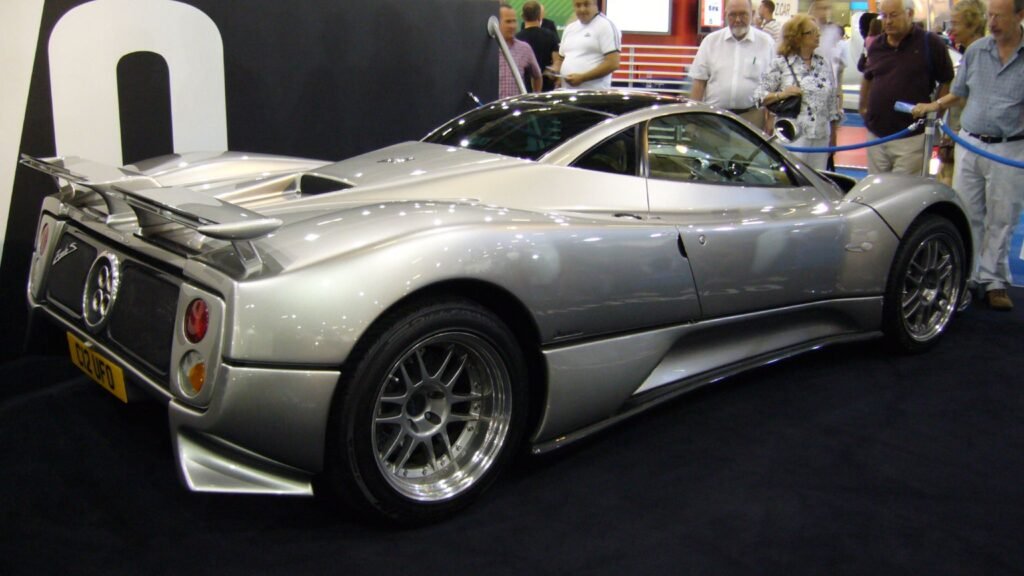
The Zonda’s proportions scream width and low stance. Up front, the splitter and side air intakes look cool, but they’re also doing real work.
Pagani’s design approach? A little Leonardo da Vinci, a little mad scientist. The result is a supercar that looks like it’s moving even when it’s parked.
Buyers could choose exposed carbon fiber or painted finishes. Most went for the raw carbon look—why hide what makes the car special?
Aerodynamic Features and Impact on Performance
The Zonda C12 packs several aero innovations that became Pagani trademarks. The rear wing uses advanced materials and flexes at high speeds to keep downforce just right.
Aerodynamic Components:
- Front splitter: Reduces lift and channels air
- Side air intakes: Cool the engine and brakes
- Rear diffuser: Smooths underbody airflow
- Active rear wing: Adjusts with speed and conditions
The underbody is flat carbon fiber, smoothing airflow and chopping drag. Pagani tested these parts using the Zonda La Nonna prototype in 1998, tweaking every detail for the final production car.
At speed, the car generates real downforce. That means more grip in corners and rock-steady stability when you’re flirting with 185 mph.
Wind tunnel work shaped every vent and curve. Nothing’s there just for show—every line has a job.
Interior Craftsmanship and Driver Experience
Step inside the Zonda C12, and you’ll see Pagani’s obsession with detail. Every surface gets the hand-finished touch, using only the best materials.
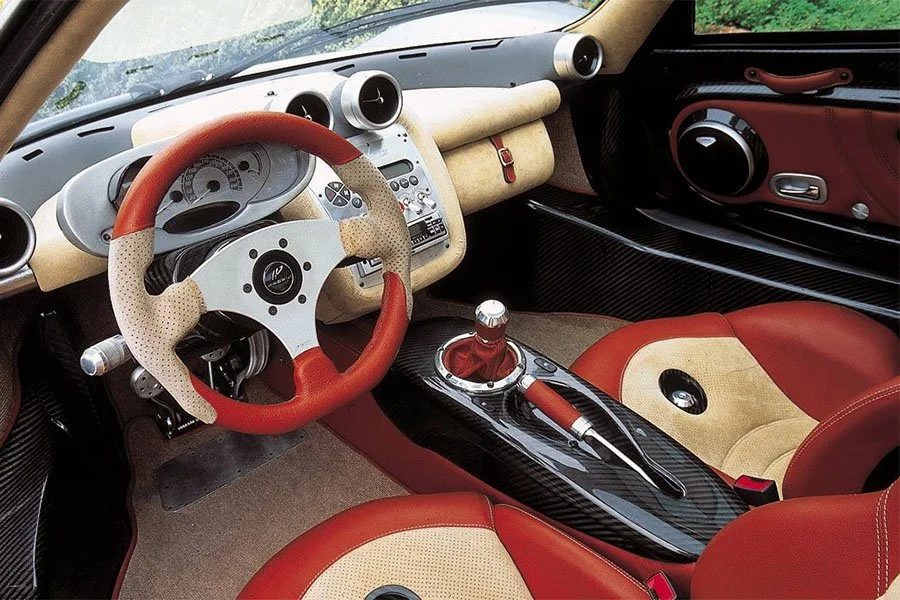
Interior Materials:
- Leather: Hand-stitched throughout
- Carbon fiber: Dashboard and doors
- Aluminum: Pedals and switches
- Fabric: Race-inspired seat inserts
The interior nods to racing history and Juan Manuel Fangio. Leather straps and mixed fabrics call back to motorsport’s golden age.
You sit low, in a real race car driving position. The steering wheel and controls are all about the drive, not luxury for luxury’s sake.
Buyers can customize their interiors with bespoke leather work. Every Zonda gets individual attention on the Modena assembly line—no cookie-cutter builds here.
The gauges? Classic analog dials, because the mechanical connection matters. Storage is basically nonexistent, but who buys a Zonda for practicality?
Variants, Achievements, and Community
The Zonda C12 kicked off a whole family of wild variants, each one pushing performance even further. These models set records, won awards, and built a cult following among collectors and dreamers alike.
Key Variants and Special Editions (S, Roadster, F, R)
The Zonda S showed up a year after the C12, packing a huge seven-liter AMG V12 with 555 horsepower. It came with sharper aero and suspension tweaks, making the drive even more intense.
The Zonda Roadster landed in 2003, letting you drop the top without losing any structural strength. The carbon fiber roof panels could be tucked away in custom luggage—practical? Maybe not, but undeniably cool.
Zonda F Specifications:
- Engine: 7.3L AMG V12
- Power: 602 horsepower
- Weight: 1,230 kg
- Top Speed: 214 mph
The Zonda F, named for racing legend Juan Manuel Fangio, took road-legal performance to its peak in 2005. It added active aerodynamics and a six-speed manual for even more driver engagement.
Then came the Zonda R in 2009—a track-only beast with a 6.0-liter V12 making 750 horsepower and weighing just 1,070 kg. Only 15 of these monsters exist.
Lap Records and Prestige Awards
The Zonda F clocked a Nürburgring lap time of 7:27.82 in 2005. That’s lightning quick, proving Pagani could hang with the best in the world.
The Zonda R shattered circuit records everywhere, lapping the Nürburgring in 6:47—quicker than some older Formula 1 cars. That’s a statement.
Notable Achievements:
- Multiple “Supercar of the Year” awards
- Featured in countless “Top 10” lists
- Praised for innovative carbon fiber construction
Journalists couldn’t get enough of the Zonda’s mix of art and engineering. Its design philosophy—Italian flair meets German precision—stood out in a crowded field.
Competitors: Lamborghini Diablo and Beyond
The Lamborghini Diablo was the king when the Zonda C12 dropped in 1999. With a 6.0-liter V12 pushing 550 horsepower, the Diablo was no slouch.
Ferrari’s 550 Maranello and, later, the Enzo, gave Pagani stiff competition. Sure, they matched the Zonda on speed, but they couldn’t touch its craftsmanship or rarity.
TheMcLaren F1 was the holy grail, with 627 horsepower and a curb weight under 1,140 kg. Pagani chased that benchmark with every new Zonda variant.
Key Competitors by Era:
- 1999-2002: Lamborghini Diablo, Ferrari 550 Maranello
- 2003-2006: Ferrari Enzo, Porsche Carrera GT
- 2007-2011: McLaren MP4-12C,Bugatti Veyron
Owner Demographic and Enthusiast Community
Zonda owners? They’re usually ultra-high-net-worth folks with car collections worth millions. What draws them in? The hand-built nature, the rarity, and the fact that only 140 Zondas (across all variants) ever left the factory.
The Pagani community is tiny and tight-knit. Owners gather at private track days and concours events, swapping stories and admiring each other’s cars.
Even celebrities and racing legends like Lewis Hamilton and Jay Leno have joined the Zonda club. Their love for the car has only boosted its legend.
Typical Owner Profile:
- Net worth well above $10 million
- Owns several exotic cars
- Loves exclusivity and craftsmanship
- Attends high-end automotive gatherings
With so few Zondas out there, owners get a level of exclusivity you just can’t fake. Many know each other by name—a real family, if your family happens to collect hypercars.
Market Value, Legacy, and Human Stories
The Pagani Zonda C12 has gone from pricey supercar to coveted collector’s item, with values now soaring well into seven figures. Its legacy? That’s all thanks to Horacio Pagani’s relentless vision and the passionate crew who made his dream a reality.
Price Evolution and Investment Potential
The Pagani Zonda C12 debuted at the 1999 Geneva Motor Show with an original price tag of about $320,000. Fast forward to today, and you’ll see pristine examples fetching $1.5 million to $3 million at auction—an absolutely wild leap for a car that’s barely old enough to rent its own hotel room.
Early production models, especially those with unique histories or minimal mileage, have seen the strongest price appreciation. Chassis number 46, a C12 S Coupé, appeared at Bonhams auction after it got a serious upgrade to F specification, which collectors go nuts for.
Key Investment Factors:
- Only 5 Pagani Zonda C12S were made in total by 2019—scarcity is an understatement.
- This was Pagani Automobili’s debut model, the one that started it all.
- Every car is hand-built with a carbon fiber body—no shortcuts, just pure craftsmanship.
- Mercedes-AMG V12 partnership means serious performance and a bit of German reliability in an Italian suit.
That rarity factor? It’s like rocket fuel for values. Collectors know the C12 is the cornerstone of Pagani’s hypercar legacy, and that’s not changing anytime soon.
Ownership Costs and Maintenance Insights
Owning a Pagani Zonda C12 isn’t for the faint-hearted—or the light-walleted. Annual maintenance usually lands somewhere between $15,000 and $25,000, and let’s be honest, you’re not taking it to the corner shop for an oil change.
Major Service Components:
- Engine work goes straight to Mercedes-AMG specialists—no exceptions.
- Carbon fiber body repairs? Only the factory or certified experts dare touch it.
- That custom interior—leather, Alcantara, the works—needs careful restoration when the time comes.
- Specialized tires last about 5,000 to 8,000 miles, so you’ll be swapping those out more often than you’d think.
Parts availability is, frankly, a headache. Pagani Automobili still supports Zonda models from their Modena HQ, but sometimes you’re waiting for custom-made bits. That’s the price of exclusivity, right?
Insurance isn’t much kinder, running $8,000 to $15,000 a year, depending on how much you drive and where you keep it. Most owners barely drive these beauties, mostly to keep mileage down and avoid wear on parts you just can’t replace easily.
Storage? It’s gotta be climate-controlled. You’ll also want to exercise the car regularly to keep everything ticking over. And if you want it looking show-ready, detailing runs $2,000 to $4,000 every few months. No one said owning a legend was easy.
Brand Impact, Quotes, and Lasting Legacy
The Zonda C12 didn’t just put Pagani on the map—it drew the map. Suddenly, Ferrari and Lamborghini had a new neighbor, and it wasn’t just another boutique dreamer. Horacio Pagani founded the company in 1992 after leaving Lamborghini, chasing a vision that most would call impossible.
“I wanted to create something that was not just fast, but beautiful—a work of art that moves,” Pagani once said. That philosophy is basically baked into every panel and stitch.
This car changed the game. It showed everyone that a tiny, passionate team could outshine the giants if they obsessed over every detail and never compromised. The C12 is the genesis of Pagani’s wild ride, and you can see its DNA in every Pagani that followed.
The C12 represents the genesis of Pagani’s remarkable automotive journey. Its influence is everywhere in the Pagani lineup—look at the Huayra or the Utopia, and you’ll spot the family resemblance instantly.
Automotive journalists couldn’t stop raving:
- “A perfect blend of art and engineering” – Road & Track
- “The most beautiful supercar of its generation” – Top Gear
Driving Experience and Expert Reviews
Let’s be honest—few cars stir the soul like the Pagani Zonda C12. Professional drivers rave about its raw, analog feel and that mechanical connection you just don’t get anymore. The naturally aspirated Mercedes-Benz V12? It’s a masterpiece. Throttle response is instant—no turbo lag, just pure, old-school power at your command.
Performance Characteristics:
- 0-60 mph in 3.7 seconds—blink and you’ll miss it
- Top speed of 185 mph (and yes, it feels every bit as dramatic as it sounds)
- Steering that’s so precise, you almost forget there’s a steering rack at all
- Race-inspired suspension that’s honestly more at home on a circuit than a city street
Motor Trend once called the driving position “perfectly balanced between comfort and control,” and I can’t help but agree. The carbon fiber chassis doesn’t just look wild—it gives the Zonda C12 a rigidity that’s rare, all while keeping the weight under 3,000 pounds. That’s featherlight in supercar terms.
Owner Feedback Highlights:
- The quad exhaust pipes belt out an intoxicating note—it’s addictive
- Surprisingly good visibility, even with that low, almost go-kart seating
- The clutch? It’s heavy. This car demands skill and patience, not just a fat wallet
- The track-focused setup means you have to respect it, especially on public roads
Driving the Zonda C12 is like playing a musical instrument—there’s no electronic safety net, just you and the machine. That old-school manual transmission? It connects you straight to the V12’s heartbeat. Every shift feels like a conversation between your hands and the engine.
On the edge, the C12’s handling feels predictable—almost reassuring for those who know what they’re doing. But don’t be fooled; it still rewards skill and punishes mistakes, making every drive a lesson in respect and adrenaline.
Final Words
Owning a Zonda C12 isn’t just having a car—it’s holding a piece of automotive poetry, where carbon fiber dances with fire-breathing V12s. It’s a dream stitched in leather, a heartbeat on wheels, a legacy you can touch. For collectors, thrill-seekers, and believers in bold visions, the Zonda isn’t just driven—it’s worshipped.
Thanks for reading! If you enjoyed this deep dive, be sure to subscribe to my email list for exclusive car reviews, insider tips, and weekly special offers on car parts, auctions, and gear — perfect for any car enthusiast.
If you have any thoughts or experiences with this car? Leave a comment below — I love hearing your opinions and sparking conversations with fellow enthusiasts.
And don’t forget to read related posts for more great content!

